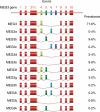MEG3 noncoding RNA: a tumor suppressor
- PMID: 22393162
- PMCID: PMC3738193
- DOI: 10.1530/JME-12-0008
MEG3 noncoding RNA: a tumor suppressor
Abstract
Maternally expressed gene 3 (MEG3) is an imprinted gene belonging to the imprinted DLK1-MEG3 locus located at chromosome 14q32.3 in humans. Its mouse ortholog, Meg3, also known as gene trap locus 2 (Gtl2), is located at distal chromosome 12. The MEG3 gene encodes a long noncoding RNA (lncRNA) and is expressed in many normal tissues. MEG3 gene expression is lost in an expanding list of primary human tumors and tumor cell lines. Multiple mechanisms contribute to the loss of MEG3 expression in tumors, including gene deletion, promoter hypermethylation, and hypermethylation of the intergenic differentially methylated region. Re-expression of MEG3 inhibits tumor cell proliferation in culture and colony formation in soft agar. This growth inhibition is partly the result of apoptosis induced by MEG3. MEG3 induces accumulation of p53 (TP53) protein, stimulates transcription from a p53-dependent promoter, and selectively regulates p53 target gene expression. Maternal deletion of the Meg3 gene in mice results in skeletal muscle defects and perinatal death. Inactivation of Meg3 leads to a significant increase in expression of angiogenesis-promoting genes and microvessel formation in the brain. These lines of evidence strongly suggest that MEG3 functions as a novel lncRNA tumor suppressor.
Figures




References
-
- Astuti D, Latif F, Wagner K, Gentle D, Cooper WN, Catchpoole D, Grundy R, Ferguson-Smith AC, Maher ER. Epigenetic alteration at the DLK1–GTL2 imprinted domain in human neoplasia: analysis of neuroblastoma, phaeochromocytoma and Wilms’ tumour. British Journal of Cancer. 2005;92:1574–1580. (doi:10.1038/sj.bjc.6602478) - PMC - PubMed
-
- Bando T, Kato Y, Ihara Y, Yamagishi F, Tsukada K, Isobe M. Loss of heterozygosity of 14q32 in colorectal carcinoma. Cancer Genetics and Cytogenetics. 1999;111:161–165. (doi:10.1016/S0165-4608(98)00242-8) - PubMed
-
- Biller BM, Alexander JM, Zervas NT, Hedley-Whyte ET, Arnold A, Klibanski A. Clonal origins of adrenocorticotropin-secreting pituitary tissue in Cushing's disease. Journal of Clinical Endocrinology and Metabolism. 1992;75:1303–1309. (doi:10.1210/jc.75.5.1303) - PubMed
Publication types
MeSH terms
Substances
Grants and funding
LinkOut - more resources
Full Text Sources
Other Literature Sources
Research Materials
Miscellaneous

